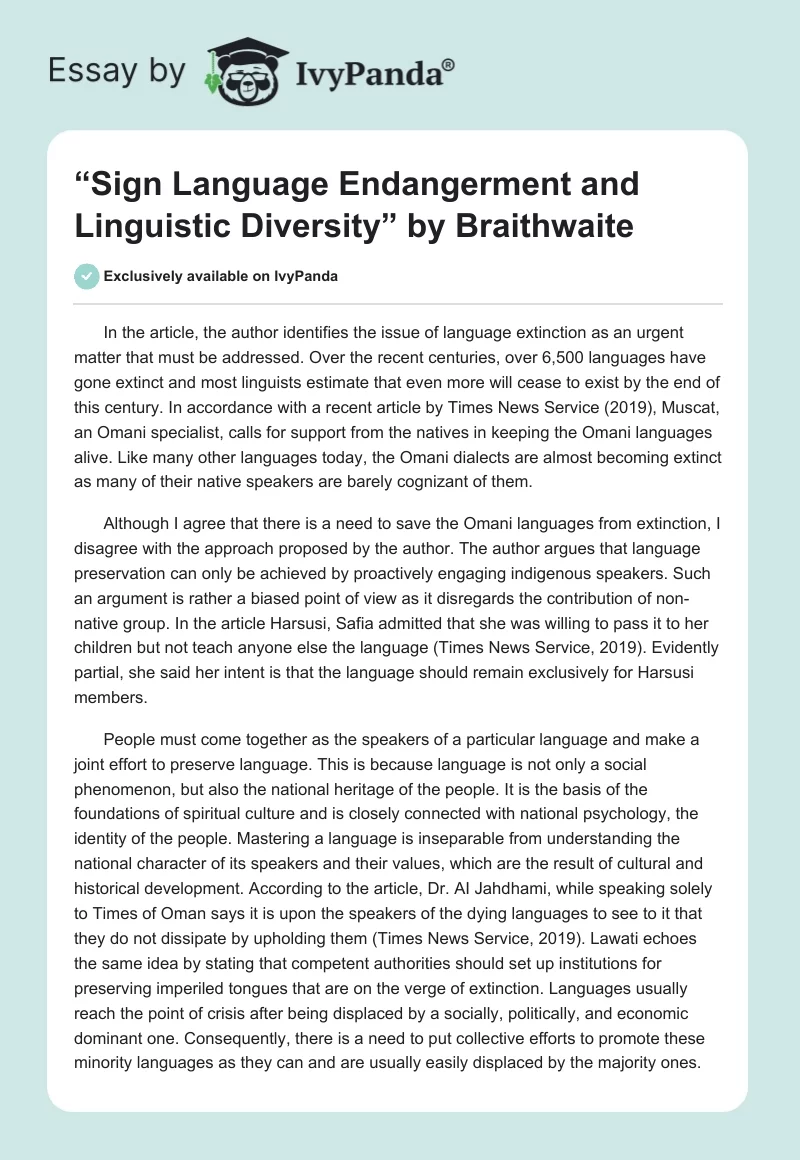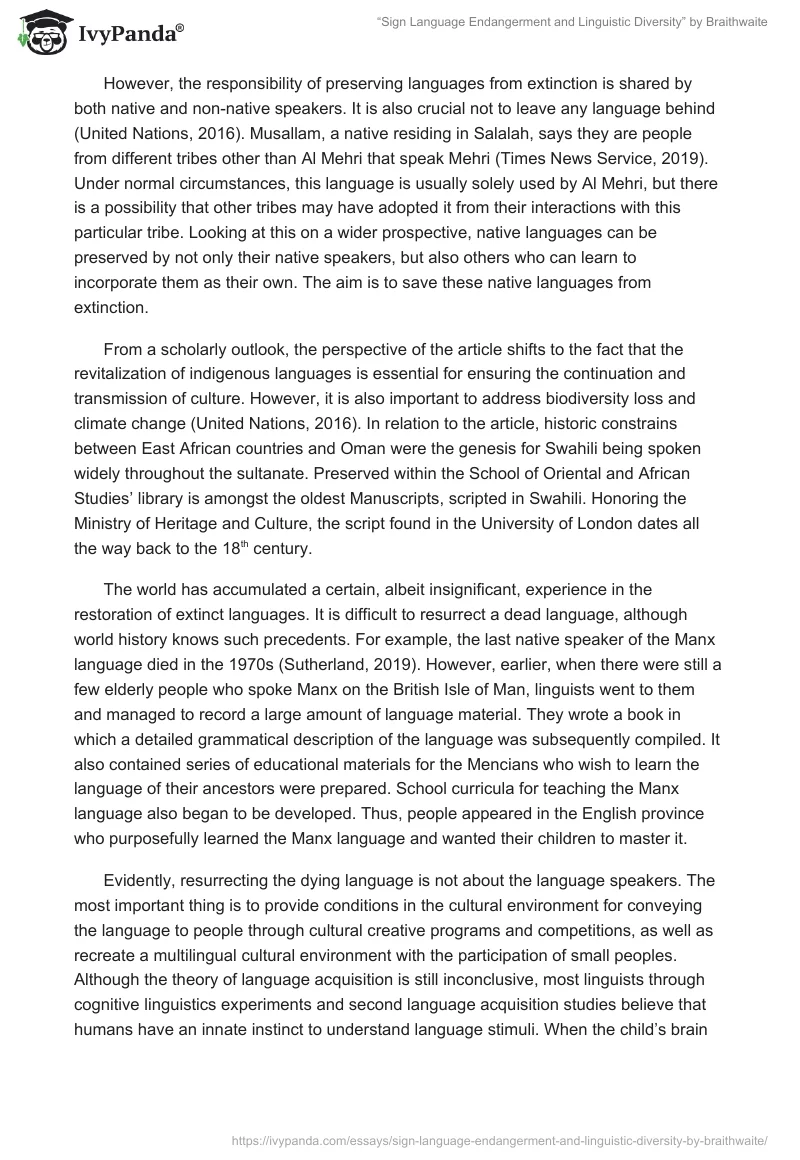In the article, the author identifies the issue of language extinction as an urgent matter that must be addressed. Over the recent centuries, over 6,500 languages have gone extinct and most linguists estimate that even more will cease to exist by the end of this century. In accordance with a recent article by Times News Service (2019), Muscat, an Omani specialist, calls for support from the natives in keeping the Omani languages alive. Like many other languages today, the Omani dialects are almost becoming extinct as many of their native speakers are barely cognizant of them.
Although I agree that there is a need to save the Omani languages from extinction, I disagree with the approach proposed by the author. The author argues that language preservation can only be achieved by proactively engaging indigenous speakers. Such an argument is rather a biased point of view as it disregards the contribution of non-native group. In the article Harsusi, Safia admitted that she was willing to pass it to her children but not teach anyone else the language (Times News Service, 2019). Evidently partial, she said her intent is that the language should remain exclusively for Harsusi members.
People must come together as the speakers of a particular language and make a joint effort to preserve language. This is because language is not only a social phenomenon, but also the national heritage of the people. It is the basis of the foundations of spiritual culture and is closely connected with national psychology, the identity of the people. Mastering a language is inseparable from understanding the national character of its speakers and their values, which are the result of cultural and historical development. According to the article, Dr. AI Jahdhami, while speaking solely to Times of Oman says it is upon the speakers of the dying languages to see to it that they do not dissipate by upholding them (Times News Service, 2019). Lawati echoes the same idea by stating that competent authorities should set up institutions for preserving imperiled tongues that are on the verge of extinction. Languages usually reach the point of crisis after being displaced by a socially, politically, and economic dominant one. Consequently, there is a need to put collective efforts to promote these minority languages as they can and are usually easily displaced by the majority ones.
However, the responsibility of preserving languages from extinction is shared by both native and non-native speakers. It is also crucial not to leave any language behind (United Nations, 2016). Musallam, a native residing in Salalah, says they are people from different tribes other than Al Mehri that speak Mehri (Times News Service, 2019). Under normal circumstances, this language is usually solely used by Al Mehri, but there is a possibility that other tribes may have adopted it from their interactions with this particular tribe. Looking at this on a wider prospective, native languages can be preserved by not only their native speakers, but also others who can learn to incorporate them as their own. The aim is to save these native languages from extinction.
From a scholarly outlook, the perspective of the article shifts to the fact that the revitalization of indigenous languages is essential for ensuring the continuation and transmission of culture. However, it is also important to address biodiversity loss and climate change (United Nations, 2016). In relation to the article, historic constrains between East African countries and Oman were the genesis for Swahili being spoken widely throughout the sultanate. Preserved within the School of Oriental and African Studies’ library is amongst the oldest Manuscripts, scripted in Swahili. Honoring the Ministry of Heritage and Culture, the script found in the University of London dates all the way back to the 18th century.
The world has accumulated a certain, albeit insignificant, experience in the restoration of extinct languages. It is difficult to resurrect a dead language, although world history knows such precedents. For example, the last native speaker of the Manx language died in the 1970s (Sutherland, 2019). However, earlier, when there were still a few elderly people who spoke Manx on the British Isle of Man, linguists went to them and managed to record a large amount of language material. They wrote a book in which a detailed grammatical description of the language was subsequently compiled. It also contained series of educational materials for the Mencians who wish to learn the language of their ancestors were prepared. School curricula for teaching the Manx language also began to be developed. Thus, people appeared in the English province who purposefully learned the Manx language and wanted their children to master it.
Evidently, resurrecting the dying language is not about the language speakers. The most important thing is to provide conditions in the cultural environment for conveying the language to people through cultural creative programs and competitions, as well as recreate a multilingual cultural environment with the participation of small peoples. Although the theory of language acquisition is still inconclusive, most linguists through cognitive linguistics experiments and second language acquisition studies believe that humans have an innate instinct to understand language stimuli. When the child’s brain has not yet been lateralized, children can master the language faster and naturally acquire the language.
Lateralization of the brain is generally considered to happen before puberty, which is the critical period of golden language learning (Critical Period). An infant who meets the above three conditions during the pre-critical period of language learning can distinguish between multiple languages learning at the age of two (Sutherland, 2019). On average, children can complete natural language acquisition before the age of five and become native speakers of the language (Sutherland, 2019).
Linguists have proven that during the critical period of language learning, the language competence is gained for a lifetime and will not disappear. In other words, if a pair of Hakka parents uses Hakka to interact with their newborn at home, when the child is five years old, he will speak the native language of Hakka (Ungsitipoonporn, 2020). Such ability is attributable to the fact that the underlying instinct still exists. From this, it can be seen that homeschooling of the mother tongue is the most effective and most affordable method in line with the physiological development of language. However, opponents pointed out that if the mother tongue can be learned at home, then native languages such as Hokkien, Hakka, and Aboriginal languages will not face the crisis of a sudden drop in the number of speakers (Sutherland, 2019). In addition, “mother tongue” in Taiwan is linked to the concepts of “ethnic identity” and “lower-level language”, which involves the unequal relationship of dialectal power. Therefore, mother tongue learning at home instead of school becomes a political issue of ethnic discrimination. This view is based on the social aspect of language.
Linguistic ecology is like natural ecology, where the weak will feed on each other, and strong words will usually squeeze or even replace the living space of weak words. The indigenous Maori language of New Zealand offers a good example. When New Zealand was colonized by the United Kingdom, English became a strong language for school teaching, official and workplace use (Braithwaite, 2019). Therefore, many Maori parents encouraged their children to learn English in order to gain a foothold in the mainstream society, which resulted in gradual decline in their indigenous language. By the 1970s, only 23.3% of adults who could speak Maori were over 40, and only 1% of children under five could speak Maori (Sutherland, 2019). Since 1975, the Maori people realized that the ethnic phonological was on the verge of extinction, and began to actively carry out the Maori language revival movement. One of the most critical linguistic policies, and the most widely borrowed method, is the “philological nest”-a semantic revival program that uses the biological capabilities of children’s language development, combined with community customs and government policies.
The Language Nest provides four to eight hours of pre-school education for children from 0 to 6 years old, and the mother or nanny who speaks Maori is responsible for the care of children (Sutherland, 2019). It let children learn Maori and pass on tribal cultural knowledge in a natural environment saturated with the language. The dialectal nest not only condenses the strength of the family and the community, but it also preserves the semantic and traditional culture. The infiltrating and internalized linguistic learning process it creates naturally cultivates the positive sense of identity of Maori children with Maori language and culture. The language nest policy also cooperated with the New Zealand government to increase the educational funding, socio-economic status and cultural value of the Maori language. The results were remarkable. Maori finally solved the endangered fate and became a successful model of language revival.
Care should be taken to ensure that native speakers value the very knowledge of their native language, use it and pass it on to children. This is because the danger of the extinction of languages is associated not so much with the number of speakers as with the lack of transmission of the language to future generations (Holes, 2011). For example, the Mordovian languages, with hundreds of thousands of speakers, are under threat, since in most communities the language is not transmitted to young people and the share of the older generation in the age structure of speakers is becoming more and more significant.
From all this, it is justifiable to conclude that the fate of these dying tongues heavily rests on their native speakers being eloquent and making joint effort to save them from extinction. It is not however far-fetched, the realization that not only the native speakers but the entire society at large has a role to play. Concerted effort involving both the indigenous and non-indigenous people is key to their preservation. The most important part of the revival of native dialects is family inheritance. In addition to paying attention to the balance of power in the local linguistic, the government should return to the natural mechanism of language acquisition and strengthen the family’s function of preserving the mother tongue. At present, the government has promoted many phonological teaching policies upwards. If it can be combined with the practice of mother tongue home learning to provide community mother tongue pre-school education, it should be able to root mother tongue in the family and the community.
References
Braithwaite, B. (2019). Sign language endangerment and linguistic diversity. Language, 95(1), 161-187. Web.
Holes, C. D. (2011). Language and identity in the Arabian Gulf. Journal of Arabian Studies, 1(2), 129-145. Web.
Sutherland, D. (2019). Literacy proficiency among students in Aotearoa-New Zealand: Why the gap between Māori and Pākehā? In Cocq, C. (Ed.), Perspectives on Indigenous writing and literacies (pp. 67-86). Brill.
Times News Service. (2019). Call to save 8 Omani languages from extinction. Web.
Ungsitipoonporn, S. (2020). Transmission of Hakka traditional knowledge from two revitalization projects in Thailand: What did they achieve? Dialectologia, 253-272.
United Nations. (2016). Protecting languages, preserving cultures. Web.


